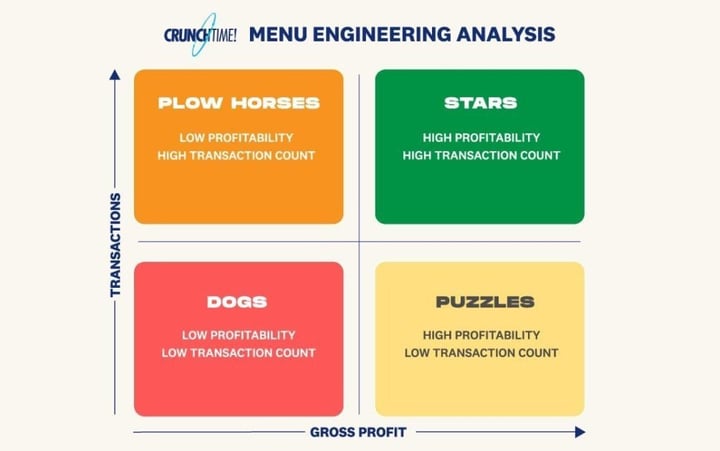
- Home
- Crunchtime Blog
- The Science Behind Profitable Menu Engineering

The Science Behind Profitable Menu Engineering
Designing your menu is an art form, but there's a science to it as well.
Now more than ever, a solid grasp of menu engineering principles is critical to the long-term success of your operation. As online ordering and off-premise environments become increasingly important to your sales, your menu can make or break your profitability. Everyone wants to optimize their menu, but it has long been a challenge for many restaurant operators.
For starters, there are conflicting ideas regarding what menu engineering is all about. Some operators consider it firmly in the realm of menu design, layout, and customer psychology. Others propose that menu engineering is less about the design of the menu and more about prices and profits. Ultimately, both are correct because menu engineering blends both art and science. And regardless of which side they fall on, all operators want to increase profits. That's why it's so important to understand the science and the data behind menu engineering.
Designing for Profitability: Mobile, Paper, or Menu Board
To build a profitable menu, you need the right data. How much does each menu item cost to make? What is each item's market price? At what price point do you turn a profit for each item? What are your most profitable and least profitable menu items? What items sell the best? Which ones sell the worst? This information empowers you to create a much more profitable menu.
Knowing what the critical data points are is only part of the solution. To truly optimize your menu, you should know how to obtain the information you need so it's always timely and accurate. And once you have that information, how do you leverage it to build a more effective and thus more profitable menu.
 The primary data points to collect are number of times a menu item was sold and how much revenue each transaction garnered. Tracking data over a longer date range will provide a better sample size. This date range should be used to calculate and report all costs with the same method across all of your operations. Remember that ingredient costs for a menu item will determine its profitability.
The primary data points to collect are number of times a menu item was sold and how much revenue each transaction garnered. Tracking data over a longer date range will provide a better sample size. This date range should be used to calculate and report all costs with the same method across all of your operations. Remember that ingredient costs for a menu item will determine its profitability.
Gathering this information will provide two critical insights - which menu items are the most (and least) profitable and which menu items have the largest (and smallest) profit margins. This allows you to be creative with your menu and your promotions. Getting guests to prioritize your more profitable menu items is still a challenge, but knowing which items to prioritize is a strong head start.
Menu Innovation Via Menu Engineering
Menu innovation is a hot button item in the restaurant industry. We touched on this topic in a recent blog. Whether you're putting a new twist on an old favorite or delving into new categories outside your traditional offerings, each act of menu innovation requires careful monitoring and data collection. Once again, it's imperative to understand how well the new item is selling, how much revenue each transaction brings in, and how much it costs to produce.
Your menu innovation ideas may be a byproduct of menu engineering. Knowing what items are most popular and most profitable provides a strong baseline for creating new items. But with so much at stake, it's important that data is accurate and easily accessible. Where do you look for the data to make these calculations?
An effective business intelligence and analytics tool will perform all of the heavy lifting required with best practice menu engineering principles. A great BI tool accesses a comprehensive data warehouse pre-populated with all of the data (and a lot more) mentioned above. This data is collected and analyzed by your enterprise back office solution for you to create optimized menus fast.
With the right tools, you can ensure your menu engineering initiative is a success.
Share this post
Related


How Your Restaurant Menu Design Can Increase Profitability

